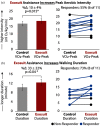Enhancing Neuroplasticity in the Chronic Phase After Stroke: Effects of a Soft Robotic Exosuit on Training Intensity and Brain-Derived Neurotrophic Factor
- PMID: 38196979
- PMCID: PMC10776098
- DOI: 10.1109/OJEMB.2023.3313396
Enhancing Neuroplasticity in the Chronic Phase After Stroke: Effects of a Soft Robotic Exosuit on Training Intensity and Brain-Derived Neurotrophic Factor
Abstract
Objective: High intensity training may enhance neuroplasticity after stroke; however, gait deficits limit the ability to achieve and sustain high walking training intensities. We hypothesize that soft robotic exosuits can facilitate speed-based gait training at higher intensities and longer durations, resulting in a corresponding increase in circulating brain-derived neurotrophic factor (BDNF). Results: Eleven individuals >6-mo post-stroke completed a two-session, pilot randomized crossover trial (NCT05138016). Maximum training speed (Δ: 0.07 ± 0.03 m/s), duration (Δ: 2.07 ± 0.88 min), and intensity (VO2 peak, Δ: 1.75 ± 0.60 ml-O2/kg/min) significantly increased (p < 0.05) during exosuit-augmented training compared to no-exosuit training. Post-session increases in BDNF (Δ: 5.96 ± 2.27 ng/ml, p = 0.03) were observed only after exosuit-augmented training. Biomechanical changes were not observed after exosuit-augmented training; however, a deterioration in gait propulsion symmetry (%Δ: -5 ± 2 %) and an increase in nonparetic propulsion (Δ: 0.9 ± 0.3 %bw) were observed (p < 0.05) after no-exosuit training. Conclusion: Soft robotic exosuits facilitate faster, longer duration, and higher intensity walking training associated with enhanced neuroplasticity.
Keywords: Brain-derived neurotrophic factor; neuroplasticity; soft robotic exosuit; stroke; walking.
© 2023 The Authors.
Figures





Similar articles
-
Effects of high-intensity gait training with and without soft robotic exosuits in people post-stroke: a development-of-concept pilot crossover trial.J Neuroeng Rehabil. 2023 Nov 7;20(1):148. doi: 10.1186/s12984-023-01267-9. J Neuroeng Rehabil. 2023. PMID: 37936135 Free PMC article. Clinical Trial.
-
Targeting Paretic Propulsion and Walking Speed With a Soft Robotic Exosuit: A Consideration-of-Concept Trial.Front Neurorobot. 2021 Jul 28;15:689577. doi: 10.3389/fnbot.2021.689577. eCollection 2021. Front Neurorobot. 2021. PMID: 34393750 Free PMC article.
-
Soft robotic exosuit augmented high intensity gait training on stroke survivors: a pilot study.J Neuroeng Rehabil. 2022 Jun 3;19(1):51. doi: 10.1186/s12984-022-01034-2. J Neuroeng Rehabil. 2022. PMID: 35655180 Free PMC article.
-
Clinical Practice Guideline to Improve Locomotor Function Following Chronic Stroke, Incomplete Spinal Cord Injury, and Brain Injury.J Neurol Phys Ther. 2020 Jan;44(1):49-100. doi: 10.1097/NPT.0000000000000303. J Neurol Phys Ther. 2020. PMID: 31834165 Review.
-
Effect of Exercise on Brain-Derived Neurotrophic Factor in Stroke Survivors: A Systematic Review and Meta-Analysis.Stroke. 2022 Dec;53(12):3706-3716. doi: 10.1161/STROKEAHA.122.039919. Epub 2022 Oct 24. Stroke. 2022. PMID: 36278401
Cited by
-
Enhancing Heart Rate-Based Estimation of Energy Expenditure and Exercise Intensity in Patients Post Stroke.Bioengineering (Basel). 2024 Dec 10;11(12):1250. doi: 10.3390/bioengineering11121250. Bioengineering (Basel). 2024. PMID: 39768068 Free PMC article.
References
-
- Kleim J. A., Jones T. A., and Schallert T., “Motor enrichment and the induction of plasticity before or after brain injury,” Neurochemical Res., vol. 28, no. 11, pp. 1757–1769, 2003. - PubMed
-
- Nepveu J.-F. et al., “A single bout of high-intensity interval training improves motor skill retention in individuals with stroke,” Neurorehabilitation Neural Repair, vol. 31, no. 8, pp. 726–735, Aug. 2017. - PubMed

